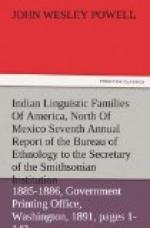> Queen Charlotte’s Island, Gallatin in Trans. and Coll. Am. Antiq. Soc., II, 15, 306, 1836 (no tribe indicated). Gallatin in Trans. Am. Eth. Soc., II, pt. 1, 77, 1848 (based on Skittagete language). Latham in Jour. Eth. Soc. Lond., 1, 154, 1848. Latham, Opuscula, 349, 1860.
X Northern, Scouler in Jour. Roy. Geog. Soc. Lond., XI, 219, 1841 (includes Queen Charlotte’s Island and tribes on islands and coast up to 60 deg. N.L.; Haidas, Massettes, Skittegas, Cumshawas). Prichard, Phys. Hist. Mankind, V, 433, 1847 (follows Scouler).
= Kygani, Dall in Proc. Am.
Ass’n, 269, 1869 (Queen Charlotte’s Ids.
or Haidahs).
X Nootka, Bancroft, Nat. Races, III,
564, 1882 (contains Quane,
probably of present family; Quactoe, Saukaulutuck).
The vocabulary referred by Gallatin[95] to “Queen Charlotte’s Islands” unquestionably belongs to the present family. In addition to being a compound word and being objectionable as a family name on account of its unwieldiness, the term is a purely geographic one and is based upon no stated tribe; hence it is not eligible for use in systematic nomenclature. As it appears in the Archaeologia Americana it represents nothing but the locality whence the vocabulary of an unknown tribe was received.
[Footnote 95: Archaeologia Americana, 1836, II, pp. 15, 306.]
The family name to be considered as next in order of date is the Northern (or Haidah) of Scouler, which appears in volume XI, Royal Geographical Society, page 218, et seq. The term as employed by Scouler is involved in much confusion, and it is somewhat difficult to determine just what tribes the author intended to cover by the designation. Reduced to its simplest form, the case stands as follows: Scouler’s primary division of the Indians of the Northwest was into two groups, the insular and the inland. The insular (and coast tribes) were then subdivided into two families, viz, Northern or Haidah family (for the terms are interchangeably used, as on page 224) and the Southern or Nootka-Columbian family. Under the Northern or Haidah family the author classes all the Indian tribes in the Russian territory, the Kolchians (Athapascas of Gallatin, 1836), the Koloshes, Ugalentzes, and Tun Ghaase (the Koluscans of Gallatin, 1836); the Atnas (Salish of Gallatin, 1836); the Kenaians (Athapascas, Gallatin, 1836); the Haidah tribes proper of Queen Charlotte Island, and the Chimesyans.
It will appear at a glance that such a heterogeneous assemblage of tribes, representing as they do several distinct stocks, can not have been classed together on purely linguistic evidence. In point of fact, Scouler’s remarkable classification seems to rest only in a very slight degree upon a linguistic basis, if indeed it can be said to have a linguistic basis at all. Consideration of “physical character, manners, and customs” were clearly accorded such weight by this author as to practically remove his Northern or Haidah family from the list of linguistic stocks.




